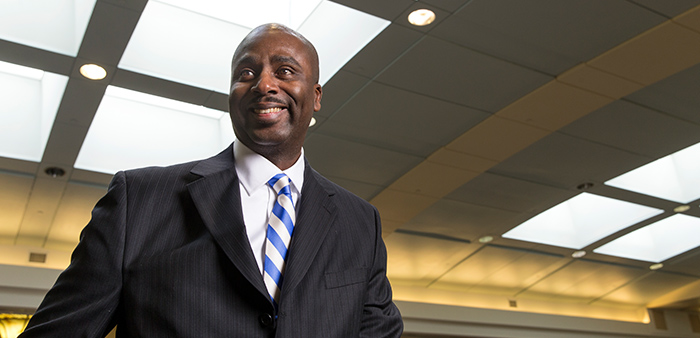Kentucky blue is seeing green
Kentucky blue is seeing green

Johnathon Davis • Lexington, KY
Retirement Tax Advisory Group
Read full biography below
403(b) plans at UK aim for growth and risk management with active investment management strategies.
Proactive Advisor Magazine: Johnathon, tell me about your practice.
I have developed a very significant practice in the 403(b) area. Having attended the University of Kentucky (UK), I have a great affinity for the university and do a lot of work with several employee groups there.
The university has an excellent benefits plan and matching contribution schedule for employees. UK employees have the option of two different custodians and over 100 investment choices. This is great, and it is coordinated with simple enrollment education on the nature of the 403(b) plans and the investment selection process.
But, frankly, no one is designated to help these employees actively navigate their way through the investment decision-making process over a time frame of 20 to 40 years with the goal of achieving a successful retirement. It’s a common refrain that I hear when meeting with employees that there was really no discipline or concrete rationale as to why they made certain investment decisions. It is often based on what they may gather from financial news sources or what they hear from their fellow employees—it is more or less a pretty random process with people hoping it will all work out in the end. This is where I come in.

How does your process usually work?
I am 100% focused on the financial advisory side. Many of my current clients are in the medical profession at UK. They are very caring, career-oriented people with demanding schedules. While they are concerned about retirement planning, they have not been able to devote time to really learn about it.
Step one is education on how investments may fit in with their overall retirement planning picture. When we have the basics squared away and I have a fundamental understanding of their investment objectives, I explain my use of third-party active investment managers to help in applying a risk-managed approach to investing. This almost always gets a positive response, and for the vast majority of my clients, I am able to manage 100% of their 403(b) assets through third-party managers.
“Investors are not aware of how much risk they are assuming in a passive investment strategy.”
Why does active management work for you and your clients?
Having been a licensed member of the financial services community for more than 20 years, and with apologies to the great James Taylor, I tell clients, “I’ve seen fire, and I’ve seen rain.” What I mean by that is not only the market displacements we have seen in the 2000s, but also how emotions come into play for investors, leading them to either poor decision-making or acting like a deer in headlights. Too often paralysis by analysis makes it justifiable to do nothing with one’s investments. And if everyone else is doing nothing, shouldn’t I be doing nothing, too?
The key selling point for active management is its ability to react to current market conditions. This is a fresh concept for most of my clients, who have been uncomfortable seeing their accounts move up and down based on the volatility of the markets. Our money managers use a quantitative approach to help smooth out that volatility, which becomes especially important during bear markets such as those in the early 2000s or 2008.
Were you always in the active management camp?
 When I first started in the business, I was indoctrinated into pretty traditional ways of thinking on diversification, rebalancing, and standard asset allocation models.
When I first started in the business, I was indoctrinated into pretty traditional ways of thinking on diversification, rebalancing, and standard asset allocation models.
Modern portfolio theory worked for nearly 50 years, but “buy-and-hold” investing is now, in my opinion, an inappropriate investment strategy when clients’ retirement futures are on the line. The average investor is likely not aware of exactly how much risk they are assuming by being passive in their investment strategy. Our mission is to help our clients have access to both growth and defensive tactics in asset management as conditions warrant.
The recent financial crisis showed investors, especially retirees, the dramatic impact a stock market decline can have on their holdings at the time when they need to access their money most. With life expectancy increasing and markets fluctuating, investors need help managing their money in tough times. We use those third-party money managers who diligently practice active management. Accounts are monitored daily, and money is moved as deemed appropriate. We are convinced that this is the best strategy to give our clients a chance to reach their goals through both up and down markets.
How do you communicate the active management story to clients?
With active money management, our whole thesis is not about making the most money when the market goes up, but losing the least when the market goes down. I use elementary math to illustrate how this works out over time. The growth of a portfolio is severely hampered by trying to make up for periods of great loss, and that is exactly what we are trying to protect against. But the beauty of active management and trend-following is that when conditions are in place to be bullish, the strategies we use should take advantage of that.
I also tend to use sports analogies with clients. They can quickly relate to the fact that every successful sports team has to have an equally strong offense and defense. I personally have had the privilege to have been affiliated with some legendary basketball coaches. I use those lessons I learned, as they are timeless and applicable to just about anything in life: Treat people with respect. Be disciplined. Be prepared for any circumstance. Then, put the best talent that you can on the floor and make sure it is well-coached and stays attentive and involved.
You can pretty quickly see how those principles can apply to working successfully with clients and in providing sound investment management practices.
 Johnathon Davis graduated from the University of Kentucky, where he was a three-year letter winner with the vaunted Wildcat basketball team. While there, he earned a degree in business marketing.
Johnathon Davis graduated from the University of Kentucky, where he was a three-year letter winner with the vaunted Wildcat basketball team. While there, he earned a degree in business marketing.
Mr. Davis has worked in several different financial-services capacities, including vice president of commercial lending with a Fortune 500 bank. His firm, Retirement Tax Advisory Group, is based in Lexington, Kentucky, and Mr. Davis is registered as a uniform investment advisor.
Mr. Davis and his wife, Ginger, have two children. His son, Jackson, is a collegiate-level basketball player himself, and his daughter, Clark, is an opera major at the University of Kentucky. When not helping his clients to achieve their financial goals, he watches and cheers for his son’s Butler University team and provides his daughter with the occasional vocal instruction.
A member of Consolidated Baptist Church and Omega Psi Phi Fraternity Inc., Mr. Davis is active in several nonprofit groups.
Disclosure: Retirement Tax Advisory Group Inc. (RTAG) is a Kentucky-based registered investment advisory firm. Securities offered through American Equity Investments, member FINRA and SIPC.
Post-publication note: Mr. Davis has been registered with American Capital Management, Inc., since September 2015.
Photography by Chris Cone

